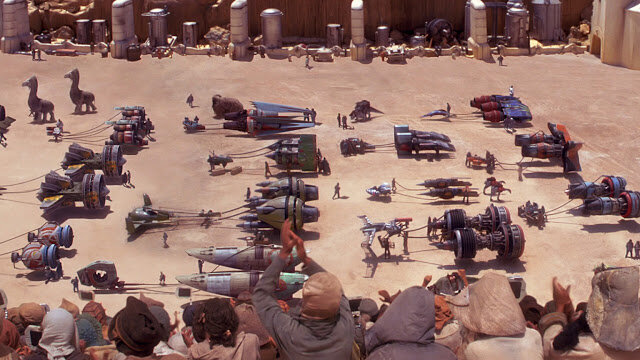The History of Podracing: Very Fast, Very Dangerous
The sport of podracing evolved from primitive races held with animal-drawn carts. Then came the Hanno Speeders, the predecessor to landspeeders. One day, Gustab Wenbus entered a race with a novel prototype vehicle. A mechanic named Phoebos designed the groundbreaking repulsorlift cockpit connected to powerful flaming jet engines. This allowed the podracer to reach the speed of 800- 900km/h. The gladiatorial sport of podracing was born, combining speed, adrenaline, and danger. Pilots gained fame and fortune. Crowds cheered at their flamboyant showmanship in addition to their skills at the helm. Spectators loved to see the fiery crashes, sometimes more so than the actual result of the race.
The setup of the podracer was delicate and not designed with safety in mind. Massive jet engines were barely linked together by plasma couplings. These engines pulled a much smaller cockpit, connected by long and fairly flexible Steelton cables. Pilots customized their vehicles with legal and illegal parts, balancing speed with maneuverability. There were no rules other than go fast, and win. Pilots frequently sabotaged each other before and during the race. Some would hire other racers to take out opponents or protect them on the racecourse.
Drivers must have extremely fast reflexes, as a miscalculation or a moment of hesitation meant a violent death. For this reason, species with additional sensory organs (like the Vulpetreen), or additional limbs (like the Xexto), had an advantage. Humans rarely finished the race unscathed, let alone won.
Criminal activities emerged around the sports of podracing. The Hutt crime syndicates drew much of their capital from the gambling business surrounding the races. Many racers themselves were involved in questionable businesses. Aldarr "Hit Man" Beedo was a known assassin in addition to being a racer. Knire Dark was a smuggler, shipping contrabands all over the galaxy as she traveled to her races. Fud Sang was actually an inmate of the prison world Oovo IV serving four consecutive life sentences (He could only compete in races held on the planet).
Podracing poster depicting Ben Quadinaros and Sebulba.
Although technically illegal, podracing flourished in the Outer Rim. The sport was broadcast all over the galaxy, even in the Core Worlds. Right before the start of the Clone Wars, criminal activities related to podracing were exposed. Many racers were arrested. Podracing was banned outright in the Core Worlds, and race attendance dropped by more than 50%. On the other hand, betting transactions remained high. Despite the legal obstacles, podracing survived into the Galactic Empire era, and even into the New Republic era. Races popped up overnight in the Outer Rim and the Unknown Territories, and vanished by the next day, always a step ahead of law enforcement.
The Galactic Podracing Circuit was the more prestigious podrace, with Sebulba as the reigning champion. It included a series of seven courses set throughout the Outer Rim: Executioner on the prison world Oovo IV (where prison wardens would ensure the course's antigravity tubes were full of debris to smash into), Sebulba's Legacy on Malastare (designed by Sebulba himself), Grabvine Gateway on Baroonda, Andobi Mountain Run on Ando Prime (where racers had to contend with icy weather conditions) , Dethro's Revenge on Ord Ibanna (which made up for its lack of sharp turns with massive drops into the gassy void), Fire Mountain Rally on Baroonda, and the Boonta Eve Classic on Tatooine (the annual race to commemorate the Hutt holiday Boonta Eve) . Other popular races included Vinta Harvest Classic on Malastare, Ando Overland on Ando Prime, and Aleen Classic on Aleen.
Podracers lined up before the race at the Boonta Eve Classic.
As popularity of Podracing declined, Swoop racing rose in its place. The sport was considerably less dangerous. Its tracks were not as complicated, with considerably less obstacles. Racers typically completed the course alone, and the racer with the best time would win. The modified swoop engines were also considerably slower, clocking at 600 km/h. Risk of critical injuries is lower. Fast reflexes were not necessary, and more humans were able to participate in the race, garnering views in the human-centric Empire. Podracing arenas would slowly convert into Swoop Arenas to keep up with changing times. However, those who missed the excitement of high speed podracing would turn to extremely dangerous and illegal Swoop races. There would always be those who challenged the legal and safety restrictions in the name of thrill.
Source(s): StarWars.com, Wookieepedia





